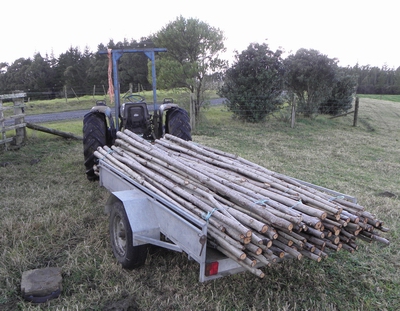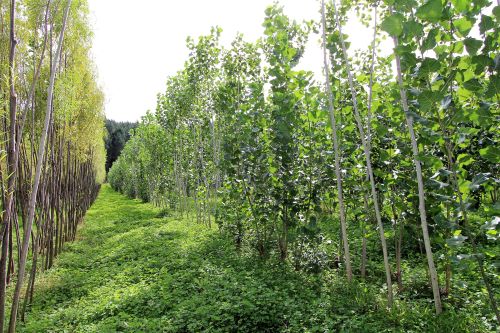Planting advice for poplars and willows
When it comes to planting your poplar and willow poles, getting things right at the beginning will give you the best results in the long term.
Council offers funding to subsidise the cost of hiring a contractor to plant your NRC poplars and willows if you are planting for erosion control. You may be eligible for up to $7 per pole or $1 per wand. You will need to provide evidence, such as an invoice, that you have engaged a contractor.
Please note the subsidised rates for 2024 have ended.
To request the subsidy, please contact our Land Management team:
P: 0800 002 004 | E: landadmin@nrc.govt.nz
When it comes to planting your poplar and willow poles, getting things right at the beginning will give you the best results in the long term.
It’s better to over-plant an area and then thin trees out at a later date to the desired stocking level. Some losses should also be expected but no greater than 25%, if all best practice steps are followed.
It is best practice to exclude cattle or stock from planted areas for at least 12-18 months to allow time for root development. Cattle rubbing or scratching up against the poles will cause root damage and the likely death of your pole. Sheep and goats can also ringbark new plantings. If possible, exclude stock altogether but if this isn’t practical, install a temporary single hotwire with pig tail standards or only graze light stock for short periods.
Land management advisors are available to offer advice on:
- Siting and planting plans
- Existing tree identification
- Crack willow eradication removal advice
- Replacement advice for existing trees in sensitive areas
- Mixed poplar/willow/native plantings.
Contact one of our land management team
Timing
In Northland, the best time of year to plant poplar and willow poles is from June through to mid-August. Remember to plan ahead and allow a few months for ordering, delivery and creating a planting plan. If you are interested in ordering poles for this season, contact the poplar & willow nursery team.
Storage and handling
- Plant as soon as possible (within 1-2 weeks of receipt) and plant from June to mid-August.
- If soil is dry wait for some reasonable winter rain, as it’s easier to plant when soils are wet.
- If you can’t plant immediately, keep your poles in fresh water (e.g. creeks or dams) before planting to maintain moisture levels. Alternatively, store with butt ends in a trough or lie in long grass in the shade. Bear in mind that if left longer than two or three weeks in water, poles will begin to develop roots that will be lost in planting.
- Store in a cool shady area away from direct sun and wind where possible, and somewhere that stock can’t trample or eat them.
Poplar and willow 3m poles
- Use 10-20m spacings where open planting to prevent erosion on moderate hill slopes.
- On moderately unstable slopes use 8-10m spacings.
- On particularly unstable or active eroding slopes, plant 5-6m apart.
- Plant to a depth of 900-1000mm of the 3m length. Poles should be firmly planted into soil with no gaps or air pockets and should not easily work free.
- Choose the best site for each pole – look for depressions, low spots and small channels where water flows or pools, as these are the spots where erosion is likely to occur and where poles will thrive.
- Make sure that soil depth is sufficient. Planting into hard clay or rocks may prove difficult and unsuccessful!
- Avoid dry exposed windy ridges, spurs and upper slopes.
- Stagger-plant in a zig-zag pattern along permanent watercourses in valley bottoms, at 10-12m apart where banks are slightly erodible; or 5-6m where actively eroding.
- The butt end of poles may either be supplied as ‘blunt’ or ‘pointed’ depending on the preference of the supplier. Poles are best sharpened on site as points are a hazard when transporting but do make planting easier. Make sure you plant the right way up.
There are three methods for planting 3m “cattle poles”:
1. The ‘Y Bar’ AKA ‘thumpers’ or pole rammers (recommended)
The ‘Y Bar’ is a double or single handled rammer similar to a waratah or fence post rammer. NRC has a limited number of these to lend out to assist with establishment. These can also be manufactured easily; plans can also be obtained from council.
-
- Establish a pilot hole slightly smaller than the pole being planted (e.g. 50-60mm for a 75mm butt end).
- Place pole in chosen location butt end down, insert pole into Y bar tube.
- Thump the pole until firm at an optimum depth of 1/3 of the total length of material (e.g. 1m for 3m pole); a tape measure may prove handy.
- If necessary, ram topsoil area tight, but avoid damaging the bark.
- Trim off any damaged tops once depth is reached.
- If using a sleeve, insert over pole.
2. Digging and post hole borers
-
- Create planting holes to 1/3 of the total length of material (e.g. 1m for 3m pole).
- Back fill and ram soil firm around pole, ensuring bark is not damaged.
- If using a sleeve, insert over pole.
3. Crowbar method or reinforcing rod
-
- Create pilot hole with long crowbar by thrusting into soil and work to suitable depth, repeating the process to achieve desired results.
- Insert the pole and back fill and ram soil firm around pole, ensuring bark is not damaged.
- If using a sleeve, insert over pole.
Poplar and willow stakes and wand material (1m - 2.5m)
- Plant stakes at 4 - 5 m spacings.
- In gullies/wet areas stagger plant in a zig-zag pattern up the gully so the root systems overlap across the gully. This helps prevent further down cutting of the gully bottom and slumping of the sides and head.
- Stagger plant in a zig-zag pattern up active gullies, at 5 – 6m down to 2 - 3 metres apart.
- Either push into soft soil to 50% of total length, or in more difficult situations create a pilot hole with a suitable implement. Heavy rubber mallets are also effective if the tops are suitably woody. Tap firmly to gain a good hold or bite in the soil. Make sure you plant the right way up.

Tree protector sleeves
Before you start planting, put protective sleeves on your poplar or willow poles – this increases the survival rate of the poles and makes it difficult for possums to climb them. Made from recycled plastics, the sleeves also protect the poles from stock damage and reduce moisture loss.
On a three metre pole, slide the sleeve on at the butt end and make sure the bottom of the sleeve is 60-70cm from the butt end. Some sleeves are designed with easy tear perforations that split and fall away as the tree grows – if this doesn't happen, remove the sleeves carefully when they become too tight.
Dynex© Tree protector sleeves designed to protect against stock and possum damage. These are available for purchase unsubsidised from the regional council – contact a poplars & willows team member on 0800 002 004.
Do I need tree protector sleeves?
A frequently asked question is, do all pole plantings require sleeves? The simple answer is no. If for example you plant poles behind a fence and stock are excluded, then provided the poles are planted firmly in the ground your chances of pole survival will be high.
Other considerations for using sleeves - are possum numbers are high in your area? Could sheep or goats have access? A few of the benefits of sleeves are listed here:
- Poles are less susceptible from rubbing by light stock, however its best to exclude any stock except sheep for the first 2-3 years of establishment.
- Smooth enclosed sleeve deters possums climbing up.
- Deflects light debris during floods.
- Bark cannot be chewed by stock, sheep or goats.
- Conserves moisture in pole during dry months

Follow-up
In late spring and early summer, Northland soils tend to dry out, contract and shrink around the trunk. Poles can loosen and work free, damaging the newly established roots. Extreme care must be taken if re-ramming poles during this stage of growth, as most roots develop near the soil surface in the top 200mm. Sand or fine soil can be used to fill gaps and firm up the pole.
Poles then should be checked regularly from around three years old to ensure sleeves aren’t starting to cause strangulation.
Maintenance
Maintenance of your poplars is necessary to ensure tree health and form and to reduce the risk of trees becoming unmanageable in future years.
- Form-pruning to a single dominant leader is recommended from years one to three (growth dependent) to improve the final tree form.
- Around year five, prune the lower 2 whorls of branches. Then, every year following, prune off a whorl of branches to a final pruned height of 6m. pruning this way will increase light levels for pasture growth and produce trees with straight form and good timber potential.
- Remove any large, steeply angled branches as early as possible as these are likely sites for splitting.
- Prune trees in autumn to minimise epicormic shoots re-growing on the main trunk.
- If a site has initially been over planted, trees should be thinned at around ten years (growth dependent), once root structures have expanded.
- Sleeves should split in years three to six. Remove the sleeve with a sharp knife if it doesn’t perforate free.
For additional planting advice, visit the Poplar & Willow Research Trust website for a series of videos providing information ranging from site selection to planting and managing poplars.
In response to increasing demand for locally produced plant material, the regional council established its own poplar and willow nursery to support the soil conservation and water quality improvement programmes. Initial work began in 2011 following the closure of the Hunters' Stix poplar nursery located at Parakao, Mangakahia Valley.

Site development and planting of rootstock began in winter 2013 with the planting of the first block. Since then council has established plantings each winter and the nursery now covers approximately 13 hectares, working towards 20 hectares.
It takes three years to produce 3m poplar poles to council specifications from cuttings. After the first harvest, poles require two years to reach specifications for harvest.
A selection of willows has also been grown to cater for hillside, gully and stream bank stabilisation. These will be available in a range of sizes from 3m tree willow poles down to 1m shrubby willow stakes.
The NZ Poplar & Willow Research Trust have some very helpful videos we recommend watching:
Assessing the site
Successful planting
Re-ramming recently planted poles
Form-pruning poplars
Interested individuals, groups and organisations are encouraged to contact:
Poplars & Willows Nursery Team
Northland Regional Council
Phone: 0800 002 004
Email: nursery@nrc.govt.nz
